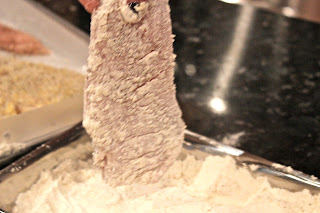Somehow, in the Fall when the apples first started appearing, I forgot to make an Apple Crisp. Last week I made both La Brea Brownies and a new recipe, Browned Butter Chocolate Chunk cookies (which I'll do here when I make them again...they were that good), but I felt that we needed something fruity as a contrast to the chocolate-y things in the treat drawer. And it's mid-season, so the apples are still crisp and not yet mealy. The Granny Smiths were the best looking apples at the store, so I bought 4 big ones. The original recipe that I use, from Beat This, a compilation of recipes published in 1993, calls for 4 cups, and an 8"x8" pyrex pan. I'm guessing that 4 cups would be around 3 of these big apples, so I decided to use a nice 8"x11" casserole dish, and to increase the topping accordingly. It turned out to be really, really good, so let's go with these measurements (which are a slight departure from the original). This is such a simple recipe that it's a good one for children and novice cooks because you really can't go wrong.
APPLE CRISP
4 large Granny Smith apples
1 Tablespoon plus 2 teaspoons fresh lemon juice
3/4 cup AP flour
1 7/8 cups old-fashioned rolled oats
1 cup light brown sugar, packed
1 7/8 teaspoons Vietnamese cinnamon
3/4 teaspoon salt
3/8 teaspoons grated nutmeg
3/16 teaspoons ginger (or close enough)
10 Tablespoons (5 ounces) unsalted butter, melted
Preheat the oven to 375 degrees F.
Cut the apples into quarters and peel them. Slice them about 1/4"-thick, like this:
Place them in an 11"x8" baking pan or pyrex pan, and toss them with the lemon juice. I didn't have a fresh lemon, so I used ReaLemon, which is okay in a pinch.
In a large mixing bowl, mix the rest of the ingredients except the butter, starting with the flour and oats,
adding the sugar and spices,
and mixing it all together. Stir in the melted butter, and spoon it over the apples,
making sure that the apples are evenly covered.
Bake for 30 minutes at 375 degrees and serve warm with ice cream. The smell of it baking will drive you crazy!
Serves 6.



































